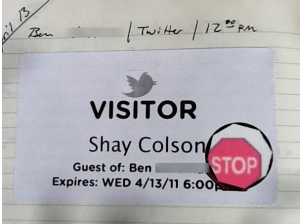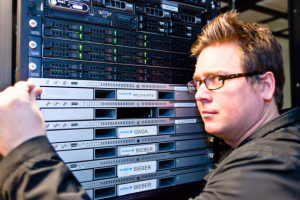I had the rare opportunity a couple of weeks ago to take a peek under the hood, as it were, and join the Twitter team for lunch at their headquarters in San Francisco’s SoMa neighborhood. It was both interesting and insightful to see just a slice of how this company operates, and I’m hoping to share some of those insights with you here.
 To start, one of the first things I noticed was the large number of employees who were taking their lunch back to their desks or off to lunch meetings. Like many high-powered startups, Twitter offers their employees the equivalent of a an “all you can eat” plan, and each meal is delicious (my lunch was no exception). But many took their food to-go. To me, this is a sign of folks who are busy, dedicated, and willing to go above and beyond to get things done.
To start, one of the first things I noticed was the large number of employees who were taking their lunch back to their desks or off to lunch meetings. Like many high-powered startups, Twitter offers their employees the equivalent of a an “all you can eat” plan, and each meal is delicious (my lunch was no exception). But many took their food to-go. To me, this is a sign of folks who are busy, dedicated, and willing to go above and beyond to get things done.
During the time of my visit, there was lots of online discussion about company leadership moving forward. The company had recently faced some downtime issues, and a shuffle of bosses at the top. Fortune Magazine even ran a cover story called “Trouble @Twitter“. But, from what I saw, you wouldn’t have known that anything was unstable, shaky, or off-course. I spoke with people who believed in the product, their team, and were still looking to innovate, despite any naysayers.
Little did they know that they were about to face two major tests of both their infrastructure and cultural significance: the Royal Wedding and the death of Osama bin Laden.
And you know what? Twitter emerged victorious on both counts.
Royal Victory
In an effort to shed their earlier “Fail Whale” image, Twitter has spent considerable time and resources to prevent service interruptions. In an official press photo (left), Twitter co-founder Biz Stone is shown adding another server labeled “Wills & Kate” to their already impressive server setup. Even if the additional “Wills & Kate” server was done in jest, it appears to have been a worthy investment.
Reports range on the official number of tweets surrounding Will and Kate’s Big Day, but a rough estimate is that the high point of wedding traffic was roughly 300 tweets per second – compared to only 74 Facebook updates per second during the same period, a traffic advantage of 4x for Twitter.
Breaking News
Later in the very same week, Twitter became the center of attention once again when reports of the death of Osama bin Laden broke and spread on the service, far faster than traditional networks could move. At their peak on Sunday night, Twitter was handling nearly 4,000 tweets per second, an immense volume of data – and nary a hiccup.
Events like these, and the Super Bowl, New Year’s Eve, and the recent earthquake in Japan highlight the centrality that Twitter has attained in our modern communication structures: when big, important things are happening, people are talking about them on Twitter.
Moving Forward
It will be interesting to see if Twitter is able to capitalize on its recent successes.
In the last week, Twitter has reportedly purchased one of the most widely used Twitter clients (TweetDeck) and all signs point towards continued growth. Twitter has been given a major tax break by the city of San Francisco and are planning to relocate to larger, more central offices next year. The are hosting summer interns for the first time, and generally maturing as a company.
If things continue to go well, leadership stabilizes, and innovations continue, I can easily see Twitter becoming an even more vital part of how humans communicate.
What do you think? Is Twitter here to stay, or will it go the way of other early innovative web services like GeoCities and Tripod? Sound off in the comments!

